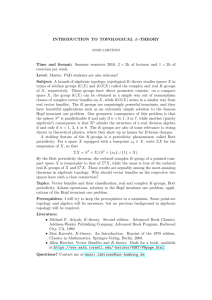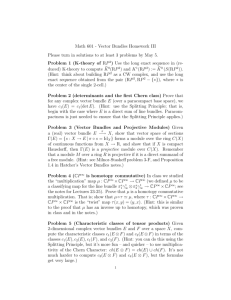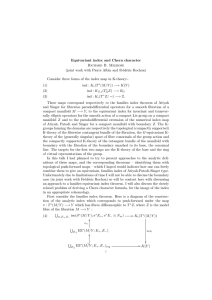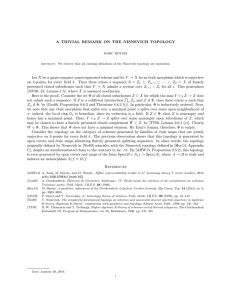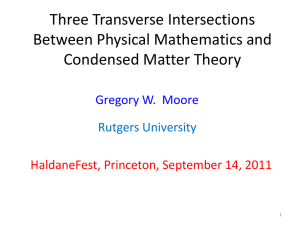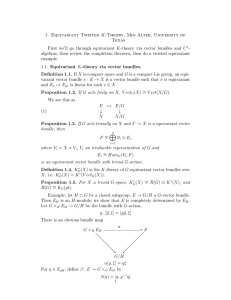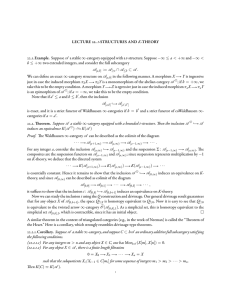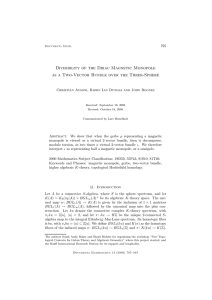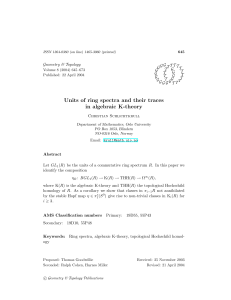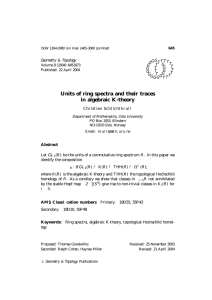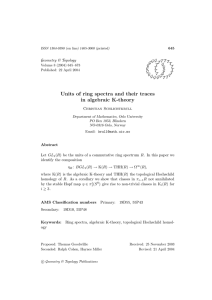1. Twisted K-Theory, Mehdi Sarikhani Khorami, Wesleyan
advertisement
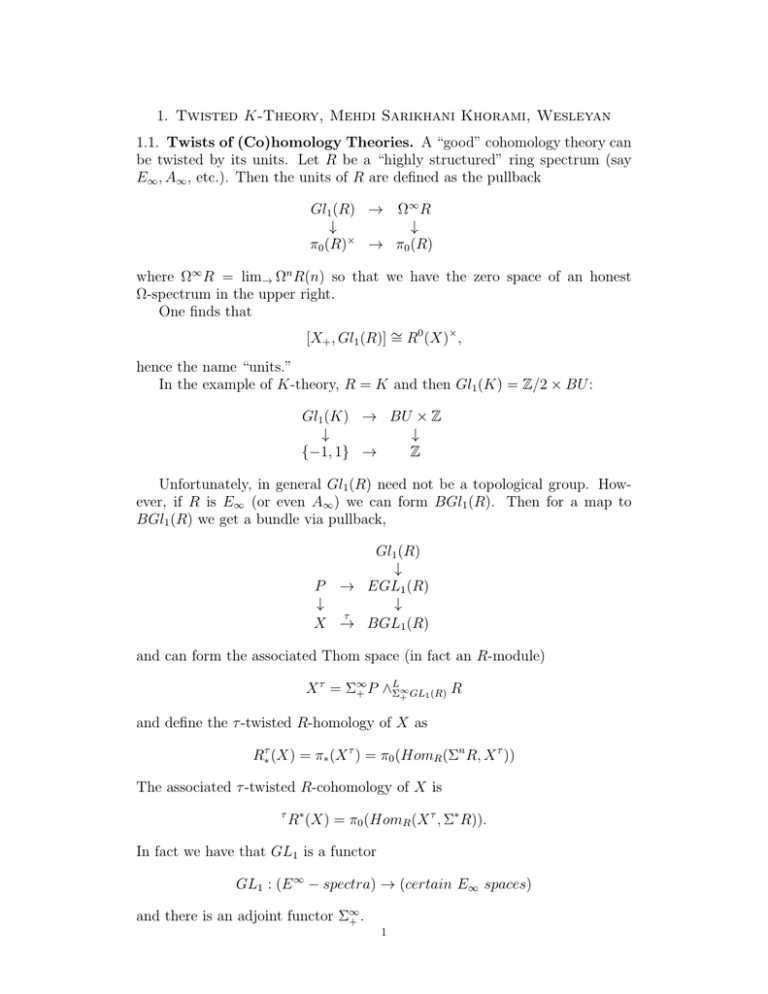
1. Twisted K-Theory, Mehdi Sarikhani Khorami, Wesleyan
1.1. Twists of (Co)homology Theories. A “good” cohomology theory can
be twisted by its units. Let R be a “highly structured” ring spectrum (say
E∞ , A∞ , etc.). Then the units of R are defined as the pullback
Gl1 (R) → Ω∞ R
↓
↓
π0 (R)× → π0 (R)
where Ω∞ R = lim→ Ωn R(n) so that we have the zero space of an honest
Ω-spectrum in the upper right.
One finds that
[X+ , Gl1 (R)] ∼
= R0 (X)× ,
hence the name “units.”
In the example of K-theory, R = K and then Gl1 (K) = Z/2 × BU :
Gl1 (K) → BU × Z
↓
↓
{−1, 1} →
Z
Unfortunately, in general Gl1 (R) need not be a topological group. However, if R is E∞ (or even A∞ ) we can form BGl1 (R). Then for a map to
BGl1 (R) we get a bundle via pullback,
Gl1 (R)
↓
P → EGL1 (R)
↓
↓
τ
X → BGL1 (R)
and can form the associated Thom space (in fact an R-module)
L
X τ = Σ∞
R
+ P ∧Σ∞
+ GL1 (R)
and define the τ -twisted R-homology of X as
R∗τ (X) = π∗ (X τ ) = π0 (HomR (Σn R, X τ ))
The associated τ -twisted R-cohomology of X is
τ
R∗ (X) = π0 (HomR (X τ , Σ∗ R)).
In fact we have that GL1 is a functor
GL1 : (E ∞ − spectra) → (certain E∞ spaces)
and there is an adjoint functor Σ∞
+.
1
2
1.2. Twists for K-Theory. We would like to use this to define twisted Ktheory. Twists can be given by
X → K(Z, 3).
We have a (functorial) action
P ic(X) × K(X) → K(X),
so that for a map f : X → Y we get a commutative diagram
P ic(Y ) × K(Y ) → K(Y )
↓ f∗
↓ f∗
P ic(X) × K(X) → K(X)
This implies that we can work at the level of classifying space. Tensor
product with line bundles gives a map
CP∞ × BU → BU
which is determined up to homotopy.
By the above reasoning twistings are given by maps to B(BU × Z/2). The
Z/2 part says certain twistings are real line bundles on X. So concentrating
on the BBU -part, a twisting is a BU bundle on X. So what we might do is
start with a class τ ∈ H 3 (X; Z) which determines a homotopy class of a map
τ ∈ [X, K(Z, 3)]
giving a K(Z, 2)-bundle P on X. Then we would like to form an associated
bundle
P ×CP∞ BU,
to recover an honest twist of K-theory. Unfortunately this doesn’t make sense
because all maps in the game are only determined up to homotopy. However,
with K-theory we are lucky and can model our maps on the nose rather than
up to homotopy, and this is precisely the content in the Atiyah-Segal paper.
So what does this construction actually do? It’s enough to see that we
have a morphism of ∞-ring spectra
∞
Σ∞
→ K,
+ CP
because in particular, such a morphism would induce a map
K(Z, 2) = CP∞ → GL1 K
which in turn induces a map
α
K(Z, 3) ∼
= BK(Z, 2) → BGL1 K.
Morally, this is a generalization of “a map from a group ring to an algebra is
induced by a map from the group to the units of the algebra.”
So then for a twisting τ we have
τ
α
X → K(Z, 3) → BGL1 K.
Then
π∗ (X ατ ) = K∗τ (X)
3
It is interesting to note that from the short exact sequence
0 → BU (1) → BSpinC → BSO → 0
we can “Thom-ify” to get
∞ ∼
Σ∞
= M BU (1) → M SpinC
+ CP
and using the Atiyah-Bott-Shapiro orientation (lifted to the spectrum level)
M SpinC → K, we get the composite
∞
Σ∞
→ M SpinC → K
+ CP
which conicides with the map described above.
1.3. K-Theory of Categories. Let S be a small additive category. Then
we can form the K-theory of this category, if we look at isomorphism classes
of objects and use the Grothendieck construction:
K(S) := {Grothendieck group of the set of isomorphism classes of objects of S}
There are many interesting examples that arise in this way: say X is a
compact space and let S be vector bundles over X. Then K(S) = K(X). If
instead we let S be the finitely generated projective modules over A = C(X)
the continuous functions on X, we recover the algebraic K-theory, which is
isomorphic to the topological one in this case.
Furthermore, if you have an additive functor(with certain added assumptions) φ : S → S 0 you can get a map on the K-theory, K(φ). But how do we
define this? Well, we look at triples (E, F, α), E, F objects of S and α : E → F
an isomorphism. Two of these triples are isomorphic if there are morphisms
f : E → E 0 , g : F → F 0 such that
φ(E)
α↓
φ(F )
φ(f )
→
φ(E 0 )
↓ α0
φ(g)
φ(F 0 )
→
commutes. Then define
K(φ) = {[(E, F, α)]}/ ∼
where
(E, F, α) ∼ (E 0 , F 0 , α0 )
if there exists a triple (G, G, σ) such that (E +G, F +G, α+σ) ∼
= (E 0 +G, F 0 +
G, α0 + σ).
Let A be a graded finite dimensional C-algebra. Take A to be central
simple, i.e. the center of A is C. (For example, let A be a Clifford algebra.) An
A-bundle over X is a locally trivial bundle over X with fibers A and transition
functions respecting the algebra structure. Fix an A-bundle A over X. Let
A (X) be the category of graded C-vector bundles which are projective as Amodules with morphisms of degree zero. Then let A (X) be the same category,
but with morphisms of all degrees. There is an inclusion ι : A (X) → A (X)
4
The K-theory of this functor is independent of the class of the bundle A in
the Brauer group over X.We can then define K-theory with local coefficients
by
K A (X) := K(ι).
Alternatively, we can take α ∈ Brauer(X) and write
K α (X) := K(ι).
If X is compact, a theorem of Serre shows that Brauer(X) ∼
= T or(H 3 (X; Z)).
